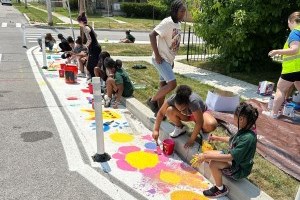Complete Streets Resources
| Recent Activities |
CHSC complete streets coordinators are working to design safer intersections (June 2023)This June, GoBike partnered with the Town of Cheektowaga and the Cheektowaga Boys & Girls Club to temporarily redesign the roads at an intersection near Town Park to lower car speed and decrease instances of dangerous turns. All of this, especially the beautiful artwork from the kids, helps make Cheektowaga Town Park more accessible to nearby residents who walk, bike, or roll.
|
| About Complete Streets |
|
Complete Streets is an approach that integrates people and place in the planning, design, construction, operation, and maintenance of our transportation networks. This approach is intended to benefit all users equitably, particularly vulnerable users and the most underinvested and underserved communities. Complete Streets are built on the premise that transportation choices should be safe, convenient, reliable, affordable, accessible, and timely regardless of race, ethnicity, religion, income, gender identity, immigration status, age, ability, languages spoken, or level of access to a personal vehicle. We strongly advocate for Complete Streets and firmly believe streets should be designed to make it easier for people to bike to work, cross the street, take public transit, or just simply interact with the street in general. Our main goal is to make the streets in our community safer, more accessible, and designed with safe + equitable access in mind.
What does a Complete Street look like? Elements that Complete Streets encompass include all things that provide benefits to both street users and its surrounding community. Some examples of elements include wide ADA compliant sidewalks, narrow travel lanes, bike lanes, curb extensions at intersections, crosswalks with reduced travel distances, transit stops, benches, and improved landscaping (ie. added trees or rain gardens).
So, if there are Complete Streets, is there such a thing as Incomplete Streets? Absolutely! Have you ever felt unsafe or uncomfortable while walking on a sidewalk next to a boulevard with several wide travel lanes and a higher speed limit? Or riding your bike within a very narrow shoulder with cars buzzing past you with little-to-no awareness that you’re even there? Take it from me – it’s never a fun experience to travel down streets like those by bike or by foot. Incomplete Streets are streets that don’t consider the needs of street users that are not traveling in a vehicle during the design process. These streets are typically designed to move cars from point A to point B as quickly as possible. As a result, it negates the consideration of non-motorists in the design process and creates a highly unsafe environment for anyone to use, including cars.
What are some benefits of transforming streets with a Complete Streets approach?
|
| Services offered |
GObike Buffalo is a major partner of Creating Healthy Schools and Communities.Below are services they can offer communities involved in the grant. GObike’s Healthy Streets Initiatives are complete streets interventions that vary in scale from crosswalk and/or bump-out treatments at a single location or intersection to full corridor redesign. Projects may be temporary pop-up projects or semi-permanent installations. Temporary pop-up projects are geared toward awareness and education, allowing communities to experience and test a new treatment before permanent infrastructure is installed. GObike responsibilities:
Local sponsor responsibilities:
Note: GObike and local sponsor responsibilities vary considerably based on the scale of the installation. Responsibilities listed are typical of a small-scale project. |

Contact Justin Booth, Executive Director of GObike Buffalo at justin@gobikebuffalo.org or (716) 218-7161.







